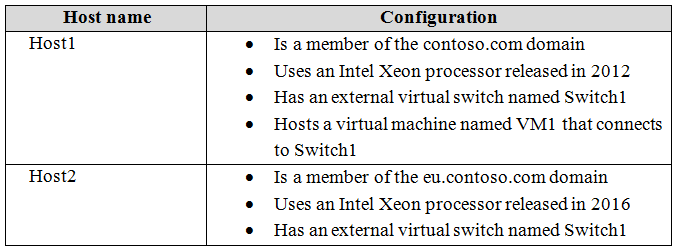Microsoft 70-740 Installation, Storage, and Compute with Windows Server 2016 Exam Practice Test
You have Nano Setver image named Diskl .vhdx.
You mount Diskl .vhdx.
You need to add a folder that contains several files to the image.
Which tool or cmdlet you should use?
Answer : A
You have a Hyper-V host that runs Windows Server 2016. The host contains a virtual machine named VM1. VM1 has resource metering enabled. You need to use resource metering to track the amount of network traffic that VM1 sends to the 10.0.0.0/8 network. Which cmdlet should you run?
Answer : A
Which container type is described below:
Provides application isolation through process and namespace isolation technology.
This container shares a kernel with the container host and all containers running on the host.
Answer : B
You have a Nano Server that runs Windows Server 2016. The Nano Server runs on a physical machine.
You have not Installed any packages on the server.
You attach a new disk to the server, and you initialize the disk as a GPT disk.
You need to create an RefS-formatted volume on the new disk.
What should you do first?
Answer : C
Note: This question is part of a series of questions that present the same scenario. Each question in the series contains a unique solution that might meet the stated goals. Some question sets might have more than one correct solution, while others might not have a correct solution.
After you answer a question in this section, you will NOT be able to return to it. As a result, these questions will not appear in the review screen.
You network contains an Active Directory forest named contoso.com. The forest contains a child domain named eu.contoso.com.
You plan to implement live migration between two Hyper-V hosts that run Windows Server 2016. The hosts are configured as shown in the following table.

You need to ensure that you can perform a live migration of VM1 from Host1 to Host2.
Solution: You replace the processor in Host1 with a processor that is identical to the processor in Host2.
Does meet the goal?
Answer : B
Note: This question is part of a series of questions that present the same scenario. Each question in the series contains a unique solution that might meet the stated goals. Some question sets might have more than one correct solution, while others might not have a correct solution.
After you answer a question in this section, you will NOT be able to return to it. As a result, these questions will not appear in the review screen.
You have two servers that run Windows Server 2016.
You plan to create a Network Load Balancing (NLB) cluster that will contain both servers.
You need to configure the network cards on the servers for the planned NLB configuration.
Solution: You configure the network cards to be on the same subnet and to have static IP addresses. You configure the cluster to use multicast.
Does this meet the goal?
Note: This question is part of a series of questions that present the same scenario. Each question in the series contains a unique solution that might meet the stated goals. Some question sets might have more than one correct solution, while others might not have a correct solution.
After you answer a question in this section, yon will NOT be able to return to it. As a result, these questions will not appear in the review screen.
You have two servers that run Windows Server 2016.
You plan to create a Network Load Balancing (NLB) cluster that will contain both servers.
You need to configure the network cards on the servers for the planned NLB configuration.
Solution: You configure the network cards to be on the same subnet and to have static IP addresses. You configure the cluster to use unicast.
Does this meet the goal?